2007 FORD FIESTA wheel
[x] Cancel search: wheelPage 1032 of 1226
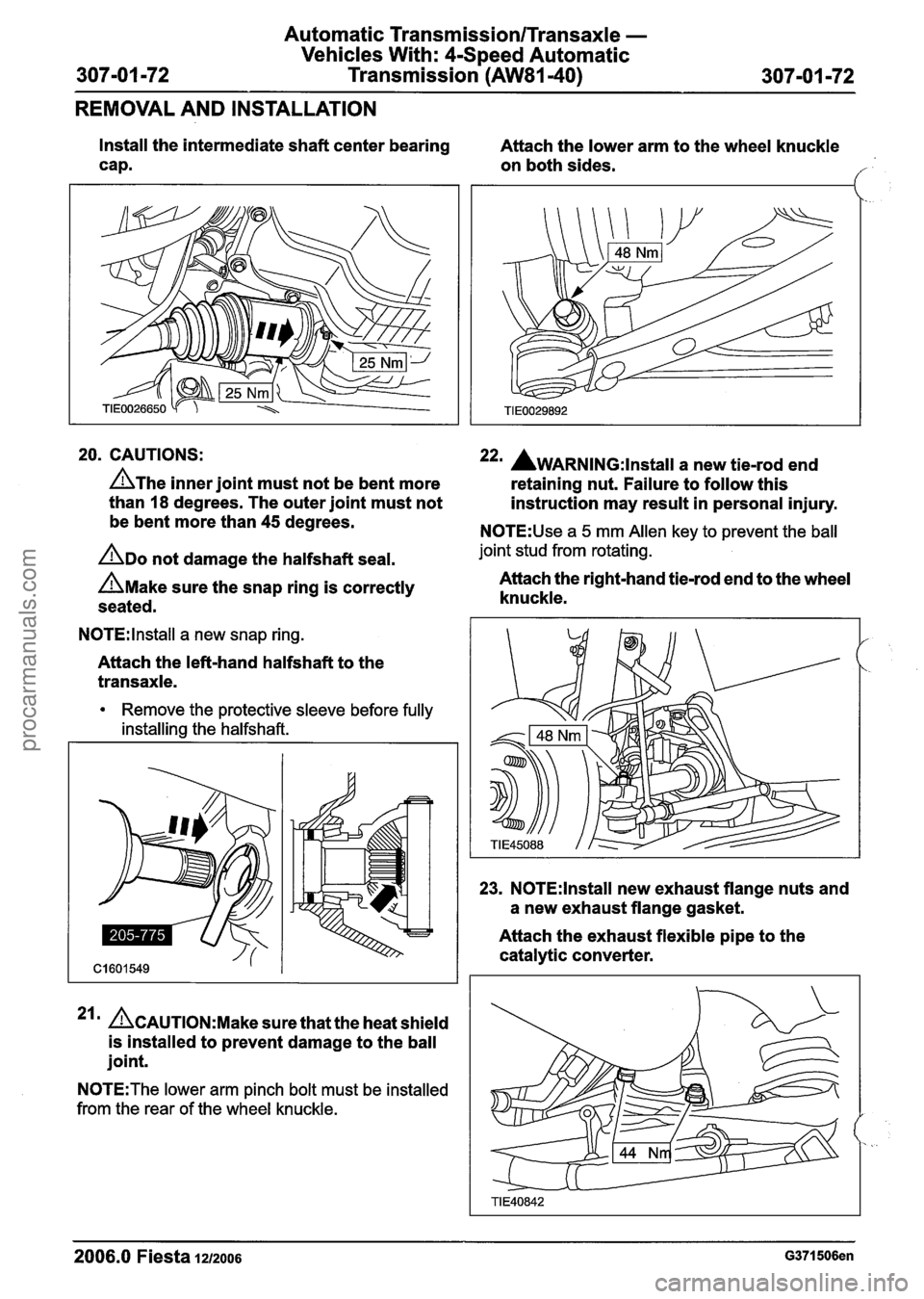
Automatic Tra
Vehicles Wit
307-01 -72 Transm nsmission/Transaxle -
h: 4-Speed Automatic
ission
(AW81-40) 307-01 -72
REMOVAL AND INSTALLATION
Install the intermediate shaft center bearing
cap. Attach
the lower arm to the wheel knuckle
on both sides.
f
20. CAUTIONS: 22m AwARNING:~~~~~~~ a new tie-rod end
A~he inner joint must not be bent more
retaining nut. Failure to follow this
than
18 degrees. The outer joint must not
instruction may result in personal injury.
be bent more than 45 degrees.
N0TE:Use a 5 mm Allen key to prevent the ball
ADO not damage the halfshaft seal. joint stud from rotating.
A~ake sure the snap ring is correctly Attach the right-hand tie-rod end
to the wheel
seated. knuckle.
N0TE:lnstall a
new snap ring.
Attach the left-hand halfshaft to the
transaxle.
Remove the protective sleeve before fully
installing the halfshaft.
ACAUTION:M~~~ sure that the heat shield
is installed to prevent damage to the ball
joint.
N0TE:The lower arm pinch bolt must be installed
from the rear of the wheel knuckle.
23. N0TE:lnstall new exhaust flange nuts and
a new exhaust flange gasket.
Attach the exhaust flexible pipe to the
catalytic converter.
2006.0 Fiesta 1212006 G371506en
procarmanuals.com
Page 1035 of 1226
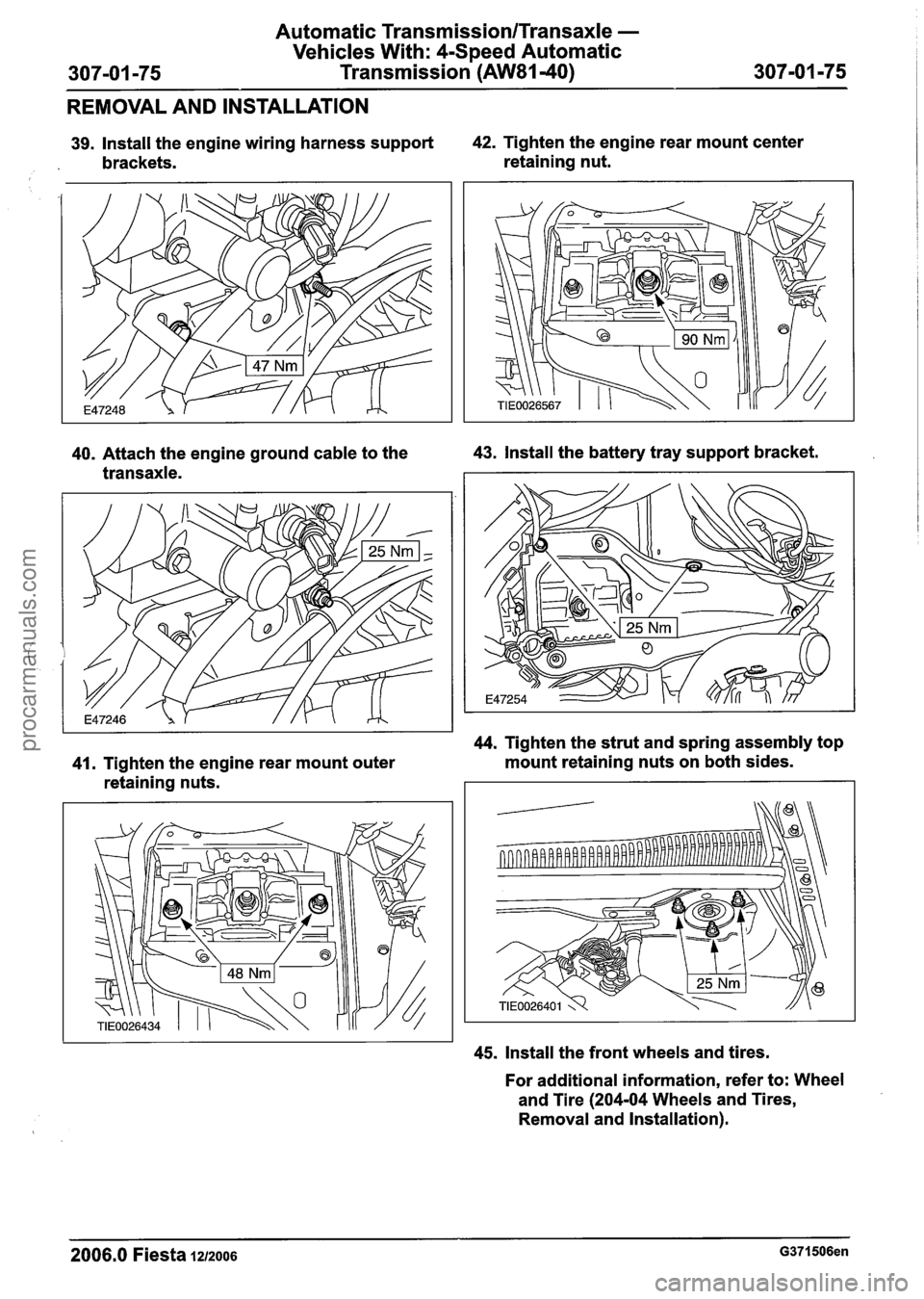
Automatic Transmission/Transaxle -
Vehicles With: 4-Speed Automatic
Transmission (AW81-40)
REMOVAL AND INSTALLATION
39. Install the engine wiring harness support 42. Tighten the engine rear mount center
brackets. retaining nut.
40. Attach the engine ground cable to the 43. Install the battery tray support bracket.
transaxle.
44. Tighten the strut and spring assembly top
41. Tighten the engine rear mount outer mount
retaining nuts on both sides.
retaining nuts.
45. Install the front wheels and tires.
For additional information, refer to: Wheel
and Tire
(204-04 Wheels and Tires,
Removal and Installation).
2006.0 Fiesta 1212006 G371506en
procarmanuals.com
Page 1061 of 1226

Manual Transmission/Transaxle and Clutch -
308-00-3 General Information 308-00-3
DIAGNOSIS AND TESTING
Manual Transaxle and Clutch
lnspection and Verification
General Equipment selected with the engine running and the parking
brake applied, without any concerns, the clutch
2. If the gear@) cannot be selected, REFER to
Symptom Chart.
Ultraviolet
fluid leak detection equipment
1. Verify the customer concern.
Transaxle noise concerns
2. Visually inspect for obvious signs of mechanical is
OK.
damage. 1. Check the engine and transaxle support for
Oil leaks.
Visibly damaged or worn components.
Visual lnspection Chart insufficient gap between the transaxle and the
body.
REFER to:
RoadlRoller Testing (1 00-00 General
Information, Description and Operation).
Mechanical 2. Road test the vehicle.
4. If the cause is not evident, verify the symptom
and REFER to Symptom Chart.
Oil leakage concerns
Loose or missing nuts or bolts.
( I The following checks should be carried out before
repairing or installing a new transaxle. 1.
Check the transaxle fluid level. If necessary,
3. If a noise occurs in various gears at the same
- - drain off any excess fluid.
The inspection and verification of manual transaxle
concerns can be considered in three main areas. 2. Clean the transaxle and the adjacent areas
carefully and road test the vehicle.
engine speed,
check if the noise also occurs in
3. If an obvious cause for an observed or reported the neutral position.
If it does, the noise is not
concern is found, correct the cause (if possible) caused
by the transaxle.
before proceeding to the next step. 4.
REFER to Symptom Chart.
Gear shifting concerns REFER to: RoadlRoller Testing (1 00-00 General
Information, Description and Operation).
1, Check the operation of the clutch: Lay a block 3. U~ing suitable ultraviolet fluid leak detection
of wood approximately
25 mm thick under the equipment, locate
the leak and check whether
clutch pedal and depress the clutch pedal as the leaking fluid
is transaxle fluid, brake fluid
far as the stop. If first or second gear can be (from the hydraulically operated clutch)
or
engine oil.
4. REFER to Symptom Chart.
Symptom Chart
Symptom Possible Sources Action
I
Clutch slippage Clutch master
cylinder.
Clutch slave cylinder.
Clutch pressure plate.
Clutch disc.
Engine or transaxle housing oil
or fluid
leak@).
GO to Pinpoint Test A.
Clutch chatter or shudder Engine and transaxle
mounts. REFER to:
Noise, Vibration and
Harshness (NVH) (1 00-04,
Diagnosis and Testing).
Clutch pressure plate.
Clutch disc.
Flywheel.
--
GO to Pinpoint Test B.
- -
2006.0 Fiesta 1212006 G25629en
procarmanuals.com
Page 1062 of 1226

Manual Transmission/Transaxle and Clutch -
308-0014 General Information 308-00-4
DIAGNOSIS AND TESTING
Symptom
Possible Sources Action
Insufficient brake fluid. FILL the brake master cylinder
reservoir to the MAX mark.
INSPECT the brake and clutch
hydraulic systems for leaks.
REPAIR as necessary. I
Air in the clutch hydraulic
system.
Clutch pedal free travel.
Clutch pressure plate.
Clutch disc.
Crankshaft end play.
Clutch pressure plate.
Clutch disc.
Crankshaft end play.
Clutch drag.
BLEED the system.
REFER to: Clutch System
Bleeding (308-00 Manual
Transmission/Transaxle and
Clutch
- General Information,
General Procedures).
GO to Pinpoint Test C.
INSTALL a new clutch disc and
pressure plate.
REFER to: Clutch Disc and
Pressure Plate (308-01
Clutch, Removal and Installa-
tion).
CHECK the crankshaft end
play.
REFER to: Crankshaft End
Play (303-00 Engine System
- General Information,
General Procedures).
GO to Pinpoint Test C.
Gearshift cable adjustment CHECK the gearshift cable
adjustment.
REFER to: Gearshift Cable
Adjustment (308-00 Manual
Transmission/Transaxle and
Clutch
- General Information,
General Procedures).
External controls. CHECK the external controls
for wear or damage. INSTALL
new components as necessary.
Gear wheels. DISASSEMBLE the transaxle. I
REFER to: Transaxle (308-03
Manual Transmis-
sion/Transaxle, Disas-
sem bly).
INSTALL new components as
necessary.
2006.0 Fiesta 1212006 G25629en
procarmanuals.com
Page 1063 of 1226
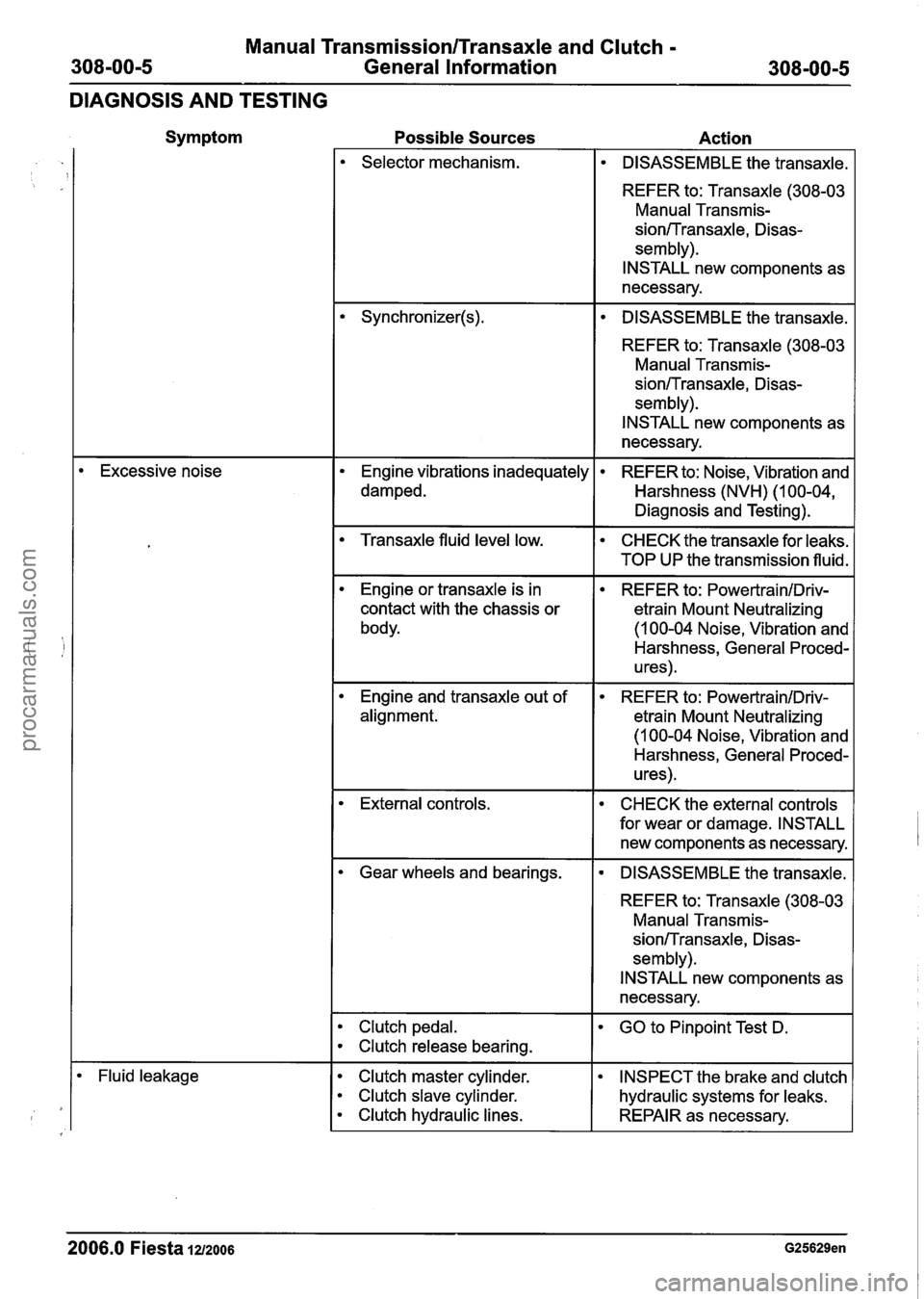
Manual Transmission/Transaxle and Clutch -
308-00-5 General Information 308-00-5
DIAGNOSIS AND TESTING
Symptom
Excessive noise Possible Sources
Action
Selector mechanism.
DISASSEMBLE the transaxle.
REFER to: Transaxle (308-03 Manual Transmis-
sionITransaxle, Disas-
sem bly).
INSTALL new components as
necessary.
DISASSEMBLE the transaxle.
REFER to: Transaxle (308-03 Manual Transmis-
sionITransaxle, Disas-
sem bly).
INSTALL new components as
necessary.
Engine vibrations inadequately
damped.
REFER to: Noise, Vibration and
Harshness (NVH) (1 00-04,
Diagnosis and Testing).
Transaxle fluid level low. CHECK the transaxle for leaks.
I TOP UP the transmission fluid.
Engine or transaxle is in
contact with the chassis or
body. REFER
to:
PowertrainIDriv-
etrain Mount Neutralizing
(1 00-04 Noise, Vibration and
Harshness, General Proced-
u res)
.
Engine and transaxle out of
alignment. REFER
to: PowertrainIDriv-
etrain Mount Neutralizing
(I 00-04 Noise, Vibration and
Harshness, General Proced-
u res)
.
External controls. CHECK the external controls
for wear or damage. INSTALL
new components as necessary.
Gear wheels and bearings.
DISASSEMBLE the transaxle.
REFER to: Transaxle (308-03
Manual Transmis-
sion/-rransaxle, Disas-
sem bly).
INSTALL new components as
necessary.
Clutch pedal. I GO to Pinpoint Test D.
Clutch release bearing.
Fluid leakage Clutch master cylinder.
Clutch slave cylinder.
Clutch hydraulic lines.
INSPECT the brake and clutch
hydraulic systems for leaks.
REPAIR as necessary.
2006.0 Fiesta 1212006 G25629en
procarmanuals.com
Page 1064 of 1226

Manual Transmission/Transaxle and Clutch -
308-00-6 General Information 308-00-6
DIAGNOSIS AND TESTING
Symptom Possible Sources
Action
Halfshaft seal. INSTALL
a new halfshaft seal.
REFER to: (308-03 Manual
Transmission/Transaxle)
Halfshaft Seal LH (In-vehicle
Repair),
Halfshaft Seal RH (In-vehicle
Repair).
Fluid leak between the
transaxle housing sections. DISASSEMBLE the transaxle
and clean the mating faces.
CHECK the mating faces for
damage. SEAL the transaxle
with sealant.
REFER to: Transaxle (308-03
Manual Transmis-
sion/-rransaxle, Assembly).
PINPOINT TEST A
: CLUTCH SLIPPAGE
TEST CONDITIONS
DETAILSIRESU LTSIACTIONS
Al: TEST CLUTCH SLIPPAGE
Lock the wheels and apply the parking brake.
Start the engine and engage fourth gear.
Run the engine at approximately 2000 rpm.
Release the clutch pedal slowly.
Does the engine stall when the clutch pedal is
fully released?
+ Yes Clutch OK.
+ No
GO to
A2.
A2: CHECK THE CLUTCH PEDAL OPERATION
Depress clutch pedal and allow it to return.
Does the pedal return to the initial position?
+ Yes
GO to A3.
-, No
GO to A4.
2006.0 Fiesta 1212006 G25629en
procarmanuals.com
Page 1066 of 1226
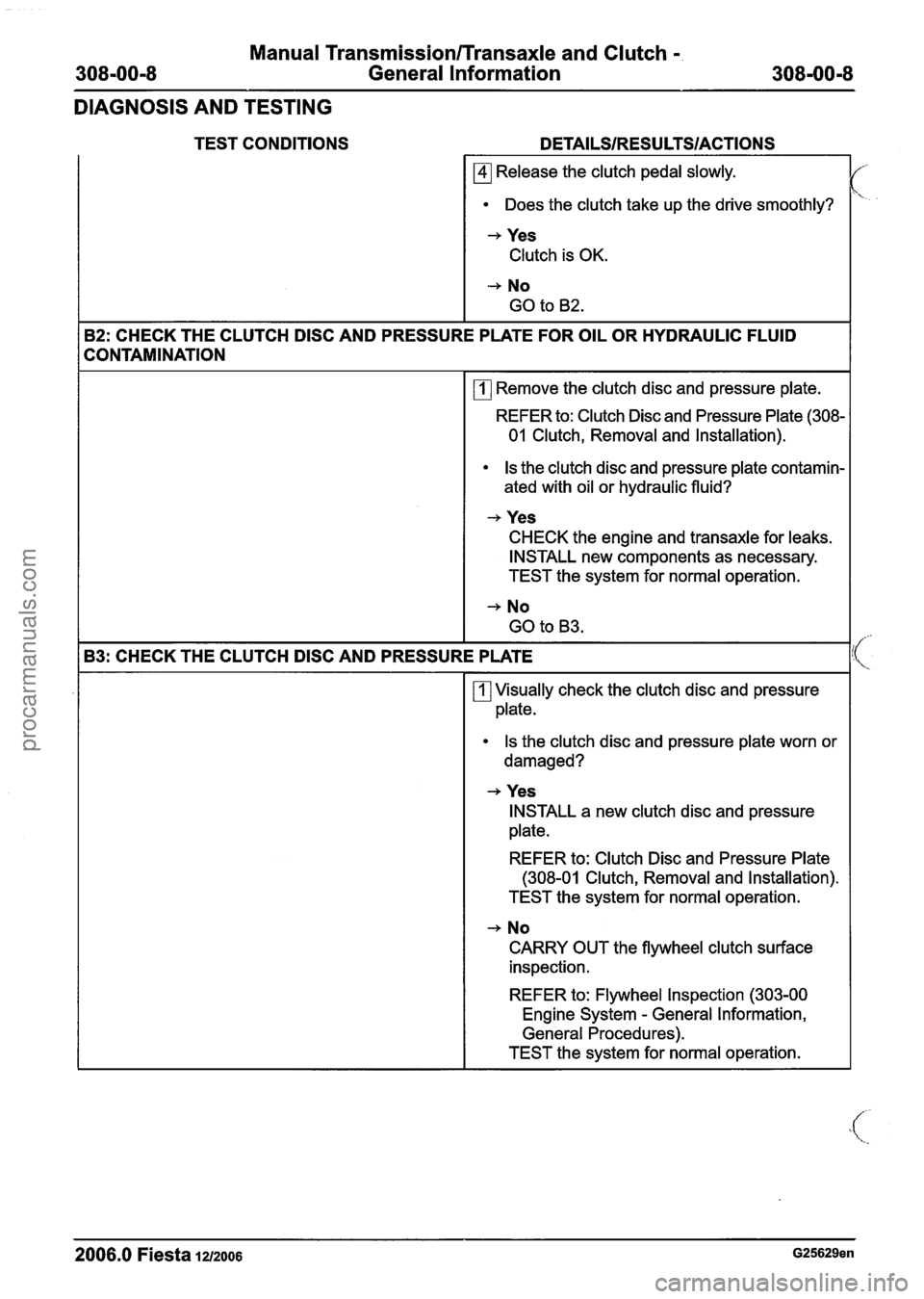
Manual Transmission/Transaxle and Clutch -
General Information
DIAGNOSIS AND TESTING
TEST CONDITIONS
Release the clutch pedal slowly.
Does the clutch take up the drive smoothly?
-+ Yes
Clutch is OK.
-+ No
GO to
B2.
B2: CHECK THE CLUTCH DlSC AND PRESSURE PLATE FOR OIL OR HYDRAULIC FLUID
CONTAMINATION
rn Remove the clutch disc and pressure plate.
REFER to: Clutch Disc and Pressure Plate (308-
01 Clutch, Removal and Installation).
Is the clutch disc and pressure plate contamin-
ated with oil or hydraulic fluid?
-+ Yes
CHECK the engine and transaxle for leaks.
INSTALL new components as necessary.
TEST the system for normal operation.
-+ No
GO to B3.
B3: CHECK THE CLUTCH
DlSC AND PRESSURE PLATE
rn Visually check the clutch disc and pressure
plate.
Is the clutch disc and pressure plate worn or
damaged?
-+ Yes INSTALL a new clutch disc and pressure
plate.
REFER to: Clutch Disc and Pressure Plate
(308-01 Clutch, Removal and Installation).
TEST the system for normal operation.
-+ No
CARRY OUT the flywheel clutch surface
inspection.
REFER to: Flywheel Inspection (303-00
Engine System
- General Information,
General Procedures).
TEST the system for normal operation.
2006.0 Fiesta 12/2006 G25629en
procarmanuals.com
Page 1076 of 1226
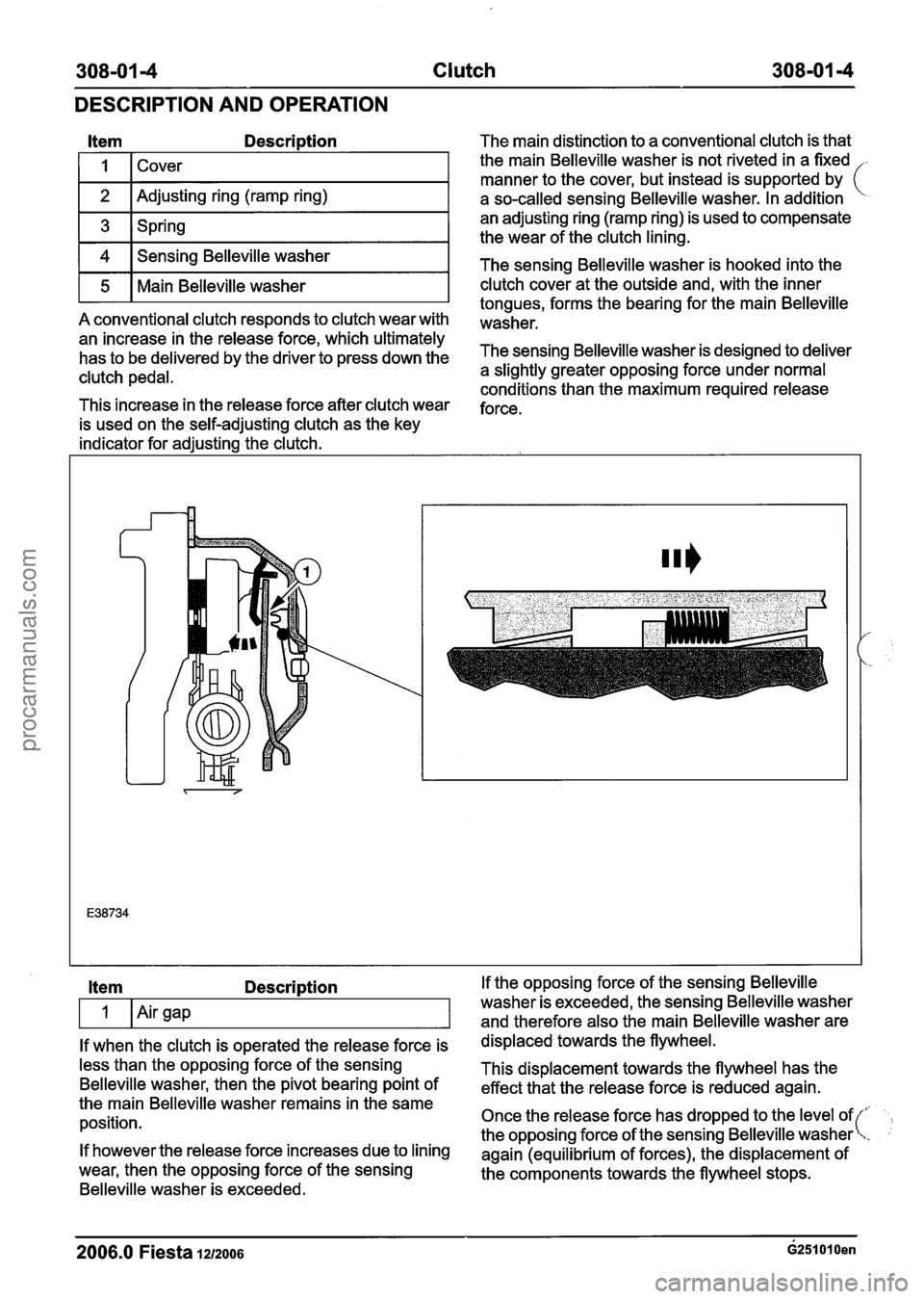
308-01 4 Clutch 308-01 -4
DESCRIPTION AND OPERATION
Item Description
I I 1 Cover I
1 2 I Adjusting ring (ramp ring) I
1 3 1 Spring I
1 4 1 Sensing Belleville washer I
r5 1 Main Belleville washer I
A conventional clutch responds to clutch wear with
an increase in the release force, which ultimately
has to be delivered by the driver to press down the
clutch pedal.
This increase in the release force after clutch wear
is used on the self-adjusting clutch as the key
indicator for adjusting the clutch. The main
distinction to a conventional clutch is that
the main Belleville washer is not riveted in a fixed
-
manner to the cover, but instead is supported by (
a so-called sensing Belleville washer. In addition
an adjusting ring (ramp ring) is used to compensate
the wear of the clutch lining.
The sensing Belleville washer is hooked into the
clutch cover at the outside and, with the inner
tongues, forms the bearing for the main Belleville
washer.
The sensing Belleville washer is designed to deliver
a slightly greater opposing force under normal
conditions than the maximum required release
force.
Item Description
If when the clutch is operated the release force is
less than the opposing force of the sensing
Belleville washer, then the pivot bearing point of
the main Belleville washer remains in the same
position.
If however the release force increases due to lining
wear, then the opposing force of the sensing
Belleville washer is exceeded. If the
opposing force of the sensing Belleville
washer is exceeded, the sensing Belleville washer
and therefore also the main Belleville washer are
displaced towards the flywheel.
This displacement towards the flywheel has the
effect that the release force is reduced again.
Once the release force has dropped to the level of
the opposing force of the sensing Belleville washer
again (equilibrium of forces), the displacement of
the components towards the flywheel stops.
2006.0 Fiesta lazoos ~251010en
procarmanuals.com